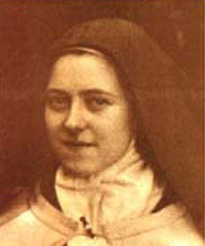Saint of the Day Online - St Therese of Lisieux
Saint of the day online, Sunday, October 01, 2017
01-10-2017
Saint Name:Saint Thérèse of Lisieux
Place: France
Birth: 1873
Death: 1897
Feast: October 01
Saint Thérèse of Lisieux who was born on January 1873 – 30 September 1897 is popularly known as "The Little Flower of Jesus" or simply "The Little Flower".
Generations of Catholics have admired this young saint, called her the "Little Flower", and found in her short life more inspiration for their own lives than in volumes by theologians.
Yet Therese died when she was 24, after having lived as cloistered Carmelite for less than ten years. She never went on missions, never founded a religious order, never performed great works. The only book of hers, published after her death, was an brief edited version of her journal called "Story of a Soul." (Collections of her letters and restored versions of her journals have been published recently.) But within 28 years of her death, the public demand was so great that she was canonized.
Over the years, some modern Catholics have turned away from her because they associate her with over- sentimentalized piety and yet the message she has for us is still as compelling and simple as it was almost a century ago.
Therese was born in France in 1873, the pampered daughter of a mother who had wanted to be a saint and a father who had wanted to be monk. The two had gotten married but determined they would be celibate until a priest told them that was not how God wanted a marriage to work! They must have followed his advice very well because they had nine children. The five children who lived were all daughters who were close all their lives.
Soon after her birth in January 1873, the outlook for the survival of Thérèse Martin was very grim. Enteritis, which had already claimed the lives of four of her siblings, threatened Thérèse, and she had to be entrusted to a wet nurse, Rose Taillé,[22] who had already nursed two of the Martin children. Rose had her own children and could not live with the Martins, so Thérèse was sent to live with her in the forests of the Bocage at Semallé.
On Holy Thursday, 2 April 1874, when she was 15 months old, she returned to Alençon where her family surrounded her with affection. She was educated in a very Catholic environment, including Mass attendance at 5:30 AM, the strict observance of fasts, and prayer to the rhythm of the liturgical year. The Martins also practiced charity, visiting the sick and elderly and welcoming the occasional vagabond to their table. Even if she wasn't the model little girl her sisters later portrayed, Thérèse was very sensitive to this education. She played at being a nun. One day she went as far as to wish her mother would die; when scolded, she explained that she wanted the happiness of Paradise for her dear mother. Described as generally a happy child, she was emotional too, and often cried: "Céline is playing with the little one with some bricks... I have to correct poor baby who gets into frightful tantrums when she can't have her own way. She rolls in the floor in despair believing all is lost. Sometimes she is so overcome she almost chokes. She is a very highly-strung child." At 22, Thérèse, then a Carmelite, admitted: "I was far from being a perfect little girl.
On 28 August 1877, Zélie died of breast cancer, aged 45. Her funeral was conducted in the basilica Notre Dame of Alençon. From 1865 she had complained of breast pain and in December 1876 a doctor told her of the seriousness of the tumour. Feeling the approach of death Madame Martin had written to Pauline in spring 1877, "You and Marie will have no difficulties with her upbringing. Her disposition is so good. She is a chosen spirit." Thérèse was barely 4 1/2 years old. Her mother's death dealt her a severe blow and later she would consider that "the first part of her life stopped that day."[citation needed]
She wrote: "Every detail of my mother's illness is still with me, specially her last weeks on earth." She remembered the bedroom scene where her dying mother received the last sacraments while Thérèse knelt and her father cried. She wrote: "When Mummy died, my happy disposition changed. I had been so lively and open; now I became diffident and oversensitive, crying if anyone looked at me. I was only happy if no one took notice of me... It was only in the intimacy of my own family, where everyone was wonderfully kind, that I could be more myself."
Three months after Zélie died, Louis Martin left Alençon, where he had spent his youth and marriage, and moved to Lisieux in the Calvados Department of Normandy, where Zélie's pharmacist brother, Isidore Guérin lived with his wife and their two daughters, Jeanne and Marie. In her last months Zélie had given up the lace business; after her death, Louis sold it. Louis leased a pretty, spacious country house, Les Buissonnets, situated in a large garden on the slope of a hill overlooking the town. Looking back, Thérèse would see the move to Les Buissonnets as the beginning of the "second period of my life, the most painful of the three: it extends from the age of four-and-a-half to fourteen, the time when I rediscovered my childhood character, and entered into the serious side of life." In Lisieux, Pauline took on the role of Thérèse's Mama. She took this role seriously, and Thérèse grew especially close to her, and to Céline, the sister closest to her in age.